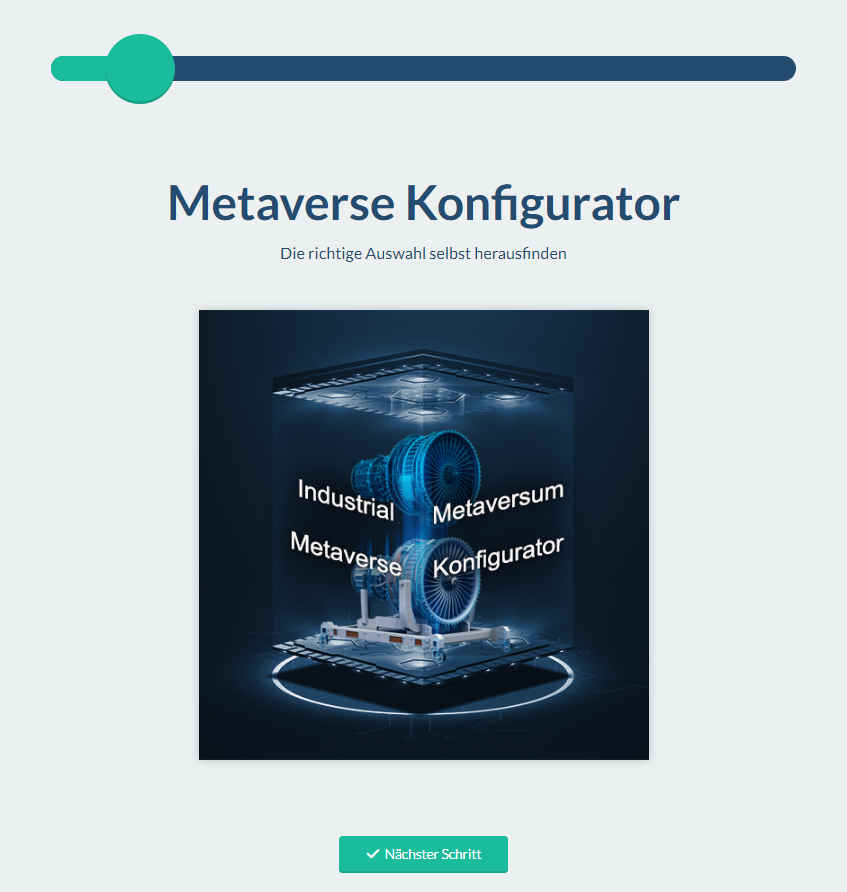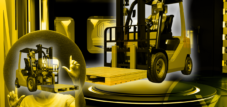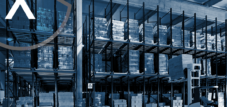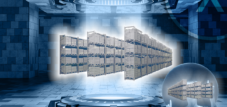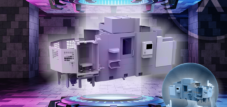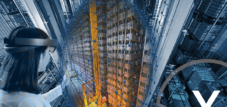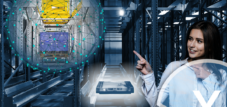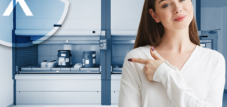Forklift Metaverse: Top ten narrow aisle forklifts and reach trucks from manufacturers and companies with a novel marketing consulting idea
Language selection 📢
Published on: June 27, 2023 / update from: June 28, 2023 - Author: Konrad Wolfenstein
Forklift Metaverse: Professional solutions for narrow warehouses - narrow aisle trucks and reach trucks
In today's digital era, it is crucial to find innovative ways to effectively present products and solutions. A revolutionary method that makes this possible is the use of a Forklift Metaverse. With this technology, companies can present their entire product range at trade fairs, events or to customers, be it in the form of a purely virtual product presentation or integration into the physical world through augmented reality.
For companies that specialize in professional solutions for tight warehouses, such as narrow aisle trucks and reach trucks, the Forklift Metaverse opens up completely new possibilities. Instead of just presenting photos or videos of the trucks, customers can now experience an immersive and interactive experience.
In a purely virtual product presentation, the Forklift Metaverse allows customers to view the forklift models from all angles. You can use the detailed 3D view to get a detailed picture of the machines and better understand their features and functions. Using simulations, customers can even run through different scenarios to see how the trucks would perform in their warehouse or production environment. These virtual experiences offer customers the opportunity to better assess the performance of narrow aisle trucks and reach trucks and make informed purchasing decisions.
However, the Forklift Metaverse goes one step further by connecting the physical world with the virtual world. By using augmented reality, customers can see the forklift models in their own environment. They can use their smartphones or AR glasses to project virtual forklifts into their warehouse and view them from different angles. This allows them to visualize the size, proportions and fit of the trucks in their actual work area and verify that the machines fit on their storage shelves and meet the space requirements. In addition, customers can use augmented reality to control the trucks interactively and test various functions to get a feel for how they operate.
The Forklift Metaverse therefore offers an impressive and effective way to showcase tight storage solutions such as narrow aisle trucks and reach trucks. By combining virtual presentations and augmented reality, customers can gain a comprehensive understanding of truck performance, features and fit. This immersive and interactive experience helps customers make informed decisions and select the right storage solutions for their specific needs.
➡️ The Forklift Metaverse opens new horizons for companies offering professional solutions for tight warehouses. By leveraging this innovative technology, they can showcase their products in a unique way and provide customers with an immersive experience. The Forklift Metaverse represents an important step towards the digital transformation of the
Our Industrial Metaverse configurator
Just try out our universally applicable (B2B/Business/Industrial) Metaverse configurator for all CAD / 3D demo options:
Xpert (B2B/Business/Industrial) Metaverse configurator for all CAD / 3D data can be used on all devices, one platform!
Suitable for:
Professional solutions for narrow warehouses: narrow aisle trucks and reach trucks
In the world of warehouse logistics and material movement, efficient and space-saving solutions play a crucial role. For companies with tight storage areas, narrow-aisle forklifts and reach trucks are indispensable work equipment. These purpose-built trucks offer a variety of benefits that allow businesses to make the most of available space while increasing productivity.
The narrow aisle stacker, also known as a narrow aisle stacker, is particularly suitable for warehouses with limited space due to its small width. These forklifts are specifically designed to maneuver in narrow aisles that are not normally accessible to traditional forklifts. Narrow aisle forklifts are typically equipped with telescopic forks, allowing the operator to lift loads to greater heights. This maximizes vertical space utilization and enables efficient storage.
Another important advantage of narrow aisle trucks is that they are often equipped with advanced navigation systems. These systems can monitor the position of the truck in real time and precisely control travel movements. For example, some advanced narrow aisle trucks use laser scanners or induction loops to automatically guide the truck along the aisle and avoid potential collisions. This not only increases safety in the warehouse, but also optimizes work processes as the forklift operator can concentrate on loading and unloading goods.
Reach trucks are another popular option for tight warehouses. Unlike narrow aisle trucks that operate in narrow aisles, reach trucks are used for high racking where pallets are stored at high heights. These forklifts are equipped with special booms, called reach masts, that can safely grip and lift loads. The reach truck allows operators to transport goods to greater heights without compromising stability.
Some modern reach trucks have smart features such as height measurement systems that can automatically detect the height of the shelves and adjust the reach accordingly. This helps handle loads efficiently and safely and reduces the risk of collisions with shelves or obstacles.
Both narrow aisle trucks and reach trucks offer benefits such as improved space utilization, increased productivity and increased efficiency in tight warehouse environments. The choice between the two depends on the specific needs of the company. The decision should take into account factors such as storage space, height of shelves, required load capacity and specific requirements of the goods.
➡️ Narrow aisle forklifts and reach trucks are valuable investments for companies that want to maximize their storage capacity and optimize their warehousing processes. By using these professional solutions, companies can increase efficiency, reduce costs and remain competitive by achieving optimal use of their limited storage space.
Top Ten: The ten best-known manufacturers and companies of narrow-aisle forklifts and reach trucks
Please note that the rankings and details may change over time as the manufacturing landscape and technological developments evolve.
Crown Equipment Corporation
Crown is a world-leading manufacturer of narrow aisle trucks and reach trucks. The company is known for its innovative technologies and ergonomic designs.
Jungheinrich AG
Jungheinrich is a renowned manufacturer of material handling technology and offers a wide range of narrow aisle trucks and reach trucks. The company attaches great importance to efficiency and sustainability.
Toyota Material Handling Group
As part of the Toyota Group, Toyota Material Handling is one of the largest manufacturers of forklift trucks in the world. They offer a variety of narrow aisle trucks and reach trucks that are known for their quality and reliability.
KION Group AG
The KION Group is an international manufacturer of industrial trucks and offers a wide range of narrow aisle trucks and reach trucks under its brands such as Linde and STILL. The company is characterized by its advanced technologies.
Hyster-Yale Materials Handling, Inc.
Hyster-Yale is a global material handling solutions provider and produces high-quality narrow aisle trucks and reach trucks. The company is known for its robust machines that are suitable for demanding applications.
Mitsubishi Logisnext Co., Ltd.
Mitsubishi Logisnext is a leading manufacturer of forklift trucks and offers a wide range of narrow aisle trucks and reach trucks. They are known for their advanced technology and reliability.
Clark Material Handling Company
Clark is an established manufacturer of forklift trucks and also offers a range of narrow aisle trucks and reach trucks. The company is known for its robust and durable machines.
Combilift Ltd.
Combilift specializes in the development of multi-way forklifts and also offers narrow-aisle forklifts and reach trucks. Their machines are characterized by their versatility and flexibility.
UniCarriers Corporation
UniCarriers is a global manufacturer of forklift trucks and offers a wide range of narrow aisle trucks and reach trucks. The company is known for its high quality and advanced technology.
Doosan Industrial Vehicle Co., Ltd.
Doosan is a manufacturer of industrial trucks and also produces narrow-aisle forklifts and reach trucks. The company places great emphasis on performance, security and ease of use.
Narrow aisle forklifts and reach trucks - the differences
Narrow aisle forklifts and reach trucks are both types of forklifts used in warehouses and logistics centers to facilitate material handling and storage of goods. Although they perform similar tasks, there are still some important differences between the two.
A narrow aisle truck, as the name suggests, is specifically designed for use in narrow aisles. These forklifts are typically narrower than traditional forklifts and can operate in aisles that are only 1.6 to 2.5 meters wide. They are characterized by their ability to move sideways or rotate on their own axis to negotiate tight turns. This allows them to use available space more efficiently and maximize storage capacity. Narrow aisle forklifts are often used in high-bay warehouses where vertical space is used optimally.
In contrast, a reach truck is not specialized for use in narrow aisles. It is more suitable for use in warehouses with wider aisles. Reach trucks are wider than narrow-aisle trucks and therefore require aisles with a minimum width of around 3.5 meters. They feature a unique telescopic mast design that allows them to push or pull loads far into shelves. This makes them ideal for stacking goods at great heights. Reach trucks are often equipped with additional features such as sideshifts or rotating forks to make maneuvering loads easier.
Another difference between the two types is their load capacity. Reach trucks are generally capable of lifting heavier loads than narrow aisle trucks. This is because reach trucks often have sturdier masts and a greater lifting height to allow pallets to be stacked on higher shelves. Narrow aisle forklifts, on the other hand, are typically designed for lighter loads due to their narrower design and special lateral movement features.
In terms of maneuverability, narrow-aisle forklifts are often slightly more maneuverable than reach trucks due to their ability to move sideways. You can maneuver in tight corners and move precisely in narrow aisles. Reach trucks, on the other hand, can be slightly less maneuverable due to their greater width and longer wheelbase.
It is important to note that both narrow aisle trucks and reach trucks are specifically designed for use in warehouse environments and require certain safety precautions. Drivers who operate these types of forklifts must have specialized training and certifications to ensure workplace safety.
➡️ Narrow aisle forklifts and reach trucks are important tools for the efficient operation of warehouses and logistics centers. While narrow aisle trucks are optimized for use in narrow aisles and save space, reach trucks offer greater load capacity and allow goods to be stacked to greater heights. The choice between the two depends on the specific needs of the warehouse and the type of loads being transported.
The fully automated alternative?
In fully automated high -bay bearings, the so -called “Automated Storage and Retrieval Systems” (ASRS) represent the counterpart to the narrow -gear stalls and thrust mast.
The “Automated Storage and Retrieval System” is referred to in German as a “automatic warehouse and withdrawal system”. The abbreviation “AS/RS” is often also used, which is translated as “automatic warehouse and provision system” in German.
ASRS systems consist of a combination of automated storage and retrieval machines (RBG) and a computer-controlled warehouse management system (LVS). Unlike traditional manual forklifts or semi-automatic narrow aisle forklifts, ASRS systems can operate with virtually no human intervention.
A RBG is a specially designed device that is able to remove pallets or containers from the shelves and bring them to the correct storage location. These devices are equipped with sophisticated sensors and gripping devices to handle the goods safely and efficiently. They are able to move precisely in the narrow aisles between shelves, making optimal use of the available space.
The LVS takes over the control and coordination of the entire warehouse operations. It manages information about inventory levels, where goods are stored and orders received. The system calculates the optimal storage placement, plans the processes and assigns the orders for storage and retrieval to the SRBs. This maximizes storage capacity and minimizes lead times.
An important advantage of ASRS systems is their high speed and accuracy. Because they are fully automated, they work around the clock without interruption and can process large quantities of goods quickly and precisely. This leads to increased efficiency, faster order processing and optimized use of space in the warehouse.
In addition, ASRS systems also provide improved safety and reduce the risk of accidents that could be caused by human error. The RBGs' advanced sensors and safety features minimize potential collisions and ensure smooth operations.
It is worth noting that ASRS systems are available in different variants to suit the specific needs of companies. For example, there are systems designed for storing pallets, while others are optimized for handling containers or small parts. Choosing the right ASRS system depends on factors such as storage capacity, product types and throughput requirements.
➡️ ASRS systems represent the ultimate counterpart to narrow aisle trucks and reach trucks in fully automated high bay warehouses. They provide an efficient, precise and safe solution for storing and retrieving goods and are a key element for modernizing and optimizing warehouse logistics in today's industry.
What are the advantages of narrow-aisle forklifts and reach trucks compared to automated storage and retrieval machines (RBG)?
Narrow-aisle forklifts and reach trucks offer several advantages compared to automated storage and retrieval machines (RBG):
flexibility
Narrow aisle trucks and reach trucks can be used in various areas and warehouse environments because they are not tied to specific rail systems or other infrastructural requirements. They can also be used in existing storage facilities with traditional shelving systems.
Cost efficiency
Compared to automated storage and retrieval machines, narrow-aisle forklifts and reach trucks are generally cheaper to purchase and install. They require less complex infrastructure and can be implemented more quickly.
adaptability
Narrow-aisle forklifts and reach trucks can be flexibly adapted to changing warehouse requirements. They can be used in different areas and are capable of moving different types of loads.
Human interaction
In contrast to automated stacker cranes, narrow aisle trucks and reach trucks require an operator. This allows for human interaction and flexibility in handling special requirements, unusual loads or unforeseen situations.
Space saving
Narrow aisle forklifts and reach trucks are able to maneuver in narrow aisles and therefore require less space in the warehouse. This allows for better use of available storage space and increases storage capacity.
➡️ However, it is important to note that automated storage and retrieval machines (RSG) also have their own advantages. They are typically faster and more efficient at performing repetitive tasks, especially in large, high-throughput warehouse facilities. Using RBGs can reduce labor costs and enable continuous 24/7 operation. The choice between narrow aisle trucks, reach trucks and automated storage and retrieval systems depends on the specific needs, budget and goals of the warehouse operation.
B2B Business Metaverse in intralogistics - New innovations, new opportunities
Intralogistics has experienced enormous technological progress in recent years, enabling companies to make their processes more efficient and increase their competitiveness. One of the most promising developments in this area is the use of digital twins in conjunction with the B2B business metaverse and a wide range of XR technologies, including extended reality, mixed reality, augmented reality and virtual reality. In combination with the use of 2D matrix codes and virtual showrooms, numerous possibilities and advantages open up for the intralogistics industry.
A digital twin is a virtual representation of a real object or process. In intralogistics, digital twins can be used to create virtual models of warehouses, factories or logistical processes. These virtual models provide detailed information and enable companies to analyze, simulate and optimize their intralogistics processes. By using digital twins, companies can improve efficiency, identify bottlenecks and resolve bottlenecks before they actually occur.
The B2B Business Metaverse is another important aspect of this development. It is a virtual environment where companies can interact with each other. In the B2B Business Metaverse, companies can present their digital twins, exchange information and close business deals. This opens up new opportunities for collaboration between companies and facilitates the exchange of information and resources in intralogistics.
The XR technologies, which include extended reality, mixed reality, augmented reality and virtual reality, also play a crucial role. Extended reality refers to all forms of reality augmentation, including virtual reality (VR), augmented reality (AR), and mixed reality (MR). These technologies allow users to immerse themselves in a virtual environment or overlay digital information into the real environment. In intralogistics, XR technologies can be used to support work processes, improve training and increase efficiency. For example, warehouse employees can use augmented reality applications to have important information about products, storage locations and orders displayed directly in their field of vision, speeding up the picking and shipping processes and reducing errors.
Another important aspect is the use of 2D matrix codes, such as QR codes, in conjunction with XR technologies. These codes can be attached to products, shelves or other logistical elements and serve as identification features. By scanning the codes with a mobile device or special glasses, users can access additional information, instructions or interactive elements. This enables warehouse workers, for example, to quickly and easily access detailed information about a product or its storage location.
Virtual showrooms represent another exciting application. These are virtual environments in which companies can showcase their products. Customers can visit these virtual showrooms and view products in a realistic environment. By using XR technologies, customers can virtually customize products, test different variants and get an accurate picture of their potential purchase. This allows companies to effectively showcase their product offerings and provide customers with an immersive shopping experience.
➡️ The combination of all these technologies opens up numerous opportunities for the intralogistics industry. Companies can optimize their logistical processes, increase efficiency, reduce errors and improve collaboration with other companies. By using digital twins in conjunction with the B2B business metaverse and XR technologies, companies can take their intralogistics processes to a new level and gain a competitive advantage. These technologies are expected to continue to develop and become widespread in the coming years, and companies should embrace them early to take advantage of the diverse benefits they offer.
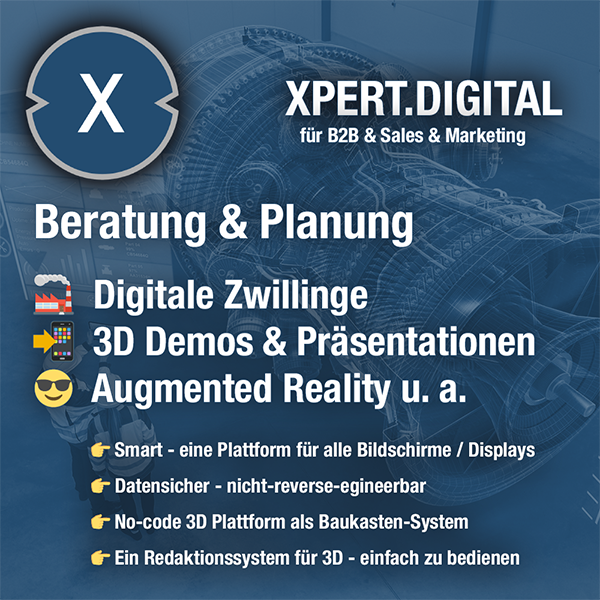
Xpert.plus -industry expert, here with its own 'xpert.digital industrial hub' in the field of mechanical engineering of over 1,000 specialist contributions
Xpert.Plus is a project from Xpert.Digital. We have many years of experience in supporting and advising on storage solutions and in warehouse optimization, which we bundle in a large network Xpert.Plus
I would be happy to serve as your personal advisor.
You can contact me by filling out the contact form below or simply call me on +49 89 89 674 804 (Munich) .
I'm looking forward to our joint project.
Xpert.Digital – Konrad Wolfenstein
Xpert.Digital is a hub for industry with a focus on digitalization, mechanical engineering, logistics/intralogistics and photovoltaics.
With our 360° business development solution, we support well-known companies from new business to after sales.
Market intelligence, smarketing, marketing automation, content development, PR, mail campaigns, personalized social media and lead nurturing are part of our digital tools.
You can find out more at: www.xpert.digital – www.xpert.solar – www.xpert.plus




